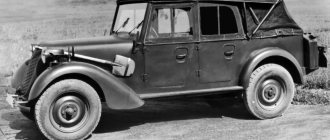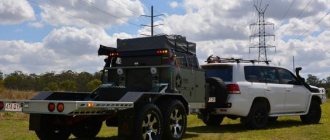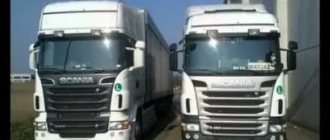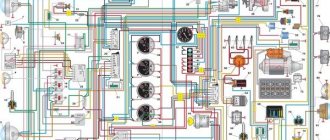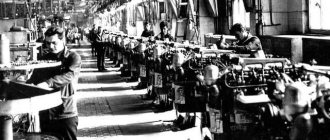Home→Driving School→New comment. History of the Ifa brand Ifa w50l technical specifications
The IFA-V50L flatbed truck transports 5.22 tons of cargo at a speed of 90 km/h. The car is equipped with a 125-horsepower diesel engine and consumes about 16 liters of fuel per 100 km. The Commissioner of the Automotive Industry Office of the German Democratic Republic, Dr. Gerhard Tietze, talks about the trucks that have been supplied to the Soviet Union since last year. Two new trucks with a cab over the engine appeared on the roads of many regions of the Soviet Union last year - a flatbed and a dump truck. These are IFA models V50L and V50L/K, built in the German Democratic Republic. Since these cars are little known to Soviet motorists, we want to tell the readers of the magazine at least in general terms about them. IFA trucks are produced by an automobile plant in Ludwigsfeld, not far from the capital of the republic, Berlin. He released his first products - five-ton trucks - in July 1965*. Today, the production program of the national enterprise is 22 thousand vehicles per year, representing about forty modifications of the basic V50L model. The plant is designed to satisfy the national economy of the GDR with a large number of vehicles for various purposes, widely unified among themselves. This greatly simplifies the organization of maintenance and the supply of spare parts. Some of the plant's products are exported to other countries. In addition to the basic model (V50L), Ludwigsfeld produces a modification with an extended chassis (V50L/Sp), with an isothermal body (V50L/IKB), refrigerated (V50L/IKST) and furniture (VbOL/M) vans, a truck with a hydraulic crane for self-loading ( V50LSH), dump trucks with one (V60L/K) and two (V50LA/K) driving axles, truck tractor (V50L/S), aerial platform (V50L/U), garbage truck (V50L/LK), as well as a sweeper (V50L/RK ), fecal (V50L/F), fire (V50L/DL, V50L/LF, V50LA/TLF) vehicles. All vehicles of the IFA-V50 family are equipped with four-cylinder (6560 cm3) diesel engines with direct fuel injection. At 2300 rpm, this diesel engine develops power of 125 hp. With. The maximum torque is 43 kgm at 1350 rpm. From the engine it is transmitted to a five-speed gearbox, in which second, third, fourth and fifth gears are synchronized. The box is not made in a block with the engine, but separately from it. This somewhat unusual design provides certain advantages during installation and dismantling. This principle is convenient for using a transfer case (on a version with all drive wheels), as well as for connecting various additional units and their drives. Among other features of the IFA-V50 gearbox, it is necessary to note the location of all shafts in a horizontal (rather than vertical) plane, the presence of four shaft supports (most often they are made of two or three) and a horizontal crankcase connector. The rear axle of the truck is also unique - the axle shafts are located not inside the axle beam, but outside. The presence of gearboxes at the wheel hubs made it possible to reduce the dimensions of the main gear reducer and thus provide increased (up to 300 mm) ground clearance. At the same time, the torque transmitted through the axle shafts decreased. Most of the modifications are basic. See "Behind the Wheel." 1966, No. 9. IFA-V50L/K dump truck with three-way unloading, unified with the V50L truck, designed for 4.4 tons of cargo and a speed of 76 km/h.30
During the period from October 13 to November 5, 1969, the Gorky Automobile Plant conducted operational tests of IFA dump trucks in comparison with the GAZ-53B dump truck.
Tests of dump trucks produced in the German Democratic Republic (GDR) were carried out to determine and evaluate performance characteristics when transporting various agricultural goods, to determine the feasibility of using IFA dump trucks for transporting agricultural goods in the central zone of the European part of the USSR.
Standard dump trucks with a 4x4 and 4x2 wheel arrangement were tested. The IFA W50 LA/Z all-wheel drive dump truck was intended only for the transportation of agricultural goods. The IFA W50 LA/K 4x2 dump truck could transport both agricultural and construction cargo.
Dump trucks were used in the Voronezh region for the export of sugar beets, then in the Gorky region, where various agricultural goods were transported at the Doskino state farm.
IFA W50 dump trucks arrived without driver's tools, W50 LA/Z - without mirrors, W50 LA/K did not have a sun visor and a windshield washer reservoir.
Production of the five-ton IFA W50 L trucks began in July 1965 in Ludwigsfeld. The trucks had 4-cylinder diesel engines producing 125 hp. at 2300 rpm. The base of the dump trucks was 3200 mm, length - 5820 mm. The IFA company also produced trucks with a wheelbase length of 3700 mm.
The W50 LA/Z dump truck had a load capacity of 4,700 kg, and the W50 L/K had a load capacity of 4,880 kg. Saransk dump truck with a 115 hp gasoline engine. had a base half a meter larger (3700 mm), and a length of 550 mm (6370 mm), but could transport only 3500 kg, that is, more than 1.39 times less than the W50 L/K, and 1.34 times than W50 LA/Z.
Diesel dump trucks, despite their large mass, turned out to be much more economical than gasoline Saransk dump trucks. On the highway, the W50 LA/Z consumed 27 liters per 100 km, the W50 L/K - 21, and the GAZ-53B - 31 liters. Operating consumption was respectively 42; 38 and 60 l. That is, per ton/kilometer, the W50 L/K dump truck was almost twice as efficient without taking into account the cost of fuel. The efficiency of W50 dump trucks in operation should actually have been even higher, since they were designed to work with trailers and were equipped with a European-style coupling device.
At the same time, high vibration and noise of the IFA W50 engine, felt in the cabin, as well as its inability to work in winter conditions, were noted. To insulate the engine, insulation was sewn onto the radiator lining. However, at temperatures below –15 °C the engines did not warm up to operating temperature.
The IFA W50 LA/Z truck was equipped with a transfer case controlled by one lever - when downshifting, the front axle was simultaneously engaged. At the same time, the speed of the car decreased from 75 to 40 km/h. The all-wheel drive truck featured a rigid suspension. It did not provide for the installation of a spare wheel. Its wheels were equipped with wide-profile tires measuring 16x20. The W50 LA/Z was fitted with regular 8.25-20 tires.
The large cabin of the IFA W50 looked unusual. The switch lever, which controls the turn signals, high beam alarm and horn activation, was found to be convenient. Drivers noted comfortable seat backs, the ability to adjust horizontally and height, as well as backrest tilt. When driving dump trucks from Gorky to Voronezh and then back, as well as during operation, the driver’s back was less tired than when working on a GAZ-53B vehicle. 16 drivers, including test drivers, took part in assessing the qualities of the cabin and the vehicle as a whole. Drivers noted the high dynamic qualities and good adaptability of the IFA W50 engine, light and comfortable steering (4x4 cars had power steering), low force on the brake pedal (hydraulic brakes were equipped with a pneumatic booster). The parking brake applied to the rear wheels. In addition, if there was compressed air in the receiver, when using the parking brake, the service brakes of all four wheels were activated, which ensured reliable braking of the car.
No less significant relief in the work of the dump truck driver was the automatically opening sides, as well as the automatic shaking of the body in the upper position to remove the compacted load of the IFA W50 LA/Z dump truck. For the GAZ-53B, all these operations were done manually.
On the IFA W50 L/K 4x2 construction dump truck, only the tailgate automatically opened and closed during rear unloading. During lateral unloading, the sides were opened manually. The loading height of the W50 L/K and GAZ-53B bodies was the same - 1360 mm, while the W50 LA/Z was 100 mm higher - 1460 mm. The IFA dump truck bodies were wider, but shorter (2350x3000 mm versus 2160x3738 mm).
The designers of the Gorky Automobile Plant under the leadership of A. Prosvirin came to the conclusion that IFA W50 dump trucks cannot be recommended for transporting agricultural cargo in the middle zone of the European part of the USSR.
How the car plant's designers were entrusted with carrying out operational tests of agricultural trucks is unknown. By that time, at the proposal of the All-Union Association “Soyuzselkhoztekhnika”, a 4x4 dump truck NAMI-072S with three-way unloading for agricultural purposes with a carrying capacity of 4.3 tons (road trains - 9 tons) was created on the NAMI-072 chassis. The NAMI dump truck was equipped with a ZMZ-41 engine with a power of 140 hp and a speed of 87.5 km/h. The Solnechnogorsk Machine Testing Station of the USSR Ministry of Agriculture (Central Machine Testing Station - TsMIS) tested this vehicle. In 1968, the dump truck received a 1st degree diploma from the All-Union Competition for the best work on unification and aggregation in mechanical engineering. The design of the dump truck used the GAZ-66 cab, body and dumping equipment of the MMZ-554 dump truck.
A serious drawback of the IFA W50 cars was, perhaps, vibration, which is characteristic of all diesel engines. In 1970 and early 1971, IFA specialists contacted US for advice on vibration issues in automobile engines. In the second half of the year, at the initiative of the GDR, a contract was signed to carry out computational and experimental work on the selection of a new suspension for IFA W-50 truck engines. By this time, IFA W50 trucks had already begun to arrive in the USSR.
The calculation work included determining the natural vibrations of the engine with 15 suspension options, random vibrations under the influence of road irregularities, as well as conducting laboratory road tests. A large amount of calculation work was carried out on the Minsk-22M digital computer by L.M. Minkin (department of computer technology - OVT). The analysis of six-coupled engine oscillations was carried out with the help of the head of the laboratory of engineering calculations OVT L.V. Korchemnogo.
Based on the calculation work carried out, two experimental options were recommended for testing on cars. In October, at the test site, together with specialists from the GDR, an experimental evaluation of the engine mount began with the participation of instrument technician V. Sidorov and test driver I. Ulanichev. The measurement results obtained from magnetographs developed by specialists of the GDR were processed on the Dnepr computer. The studies carried out made it possible to reduce the level of vibration. In 1973, IFA released the W50 with an upgraded engine. Cars were produced until 1990, 571.8 thousand units were produced.
The USSR supplied many different types of automotive equipment from the Warsaw Pact countries. The cars came from Poland, Czechoslovakia, Romania, East Germany and Yugoslavia. One of the most common machines was made by the German IFA plant.
The company arose immediately after the First World War as a machine shop and was engaged in the production of agricultural machinery. After 1945, the factories of the future IFA ended up on the territory of the GDR and were nationalized, which is reflected in the VEB prefix in the name. The new enterprise FEB Fargzeugwerk Waltershausen began producing compact trucks, for which the name “Multicar” was patented in 1958.
Bottom line
A truly unique fact is that many Ifa trucks are still functioning today, despite the lack of factory parts and time. This model and its successor L60 set a high standard for quality, increasing power to 180 horsepower and lifting capacity to 6 tons. Even in the harsh conditions of the Russian outback, cars continue to function.
The IFA brand belonged to various cars produced at several GDR enterprises that were part of the state-owned Industrial Association of the Automotive Industry (Industrieverbandes Fahrzeugbau, IFA). It existed since 1947 and played the role of a holding company or a kind of ministry of the automotive industry of the GDR. In the field of military vehicles, the first to receive the IFA brand were the Phenomen Granit trucks in 1950, and in the mid-50s. – light military “Kübelwagens” with open bodies on the chassis of front-wheel drive passenger cars IFA F9 with a 3-cylinder engine with a power of 30 hp.
Production of this 5-ton truck began in 1965 at the Industrie Werke Ludwigsfelde plant, abbreviated as IWL, built in 1937 in Ludwigsfeld, a suburb of Berlin, by Daimler-Benz -Benz) and produced aircraft engines there. During the Second World War it was destroyed, then rebuilt and in 1952 they began producing boat motors, then light army vehicles “RZ”, and from 1954 – motor scooters.
Meanwhile, at the Ernst Grube plant in Werdau, a new 4.5-tonne vehicle, the Werdau W45, was designed to replace the outdated 4-ton S4000-1 truck. The great demand for such machines in the GDR and other socialist countries forced the search for a more powerful enterprise for their production, which became the ventilator plant. With the start of production of new cars, the plant was renamed “People's Enterprise IFA” (VEB IFA-Automobilwerke).
The prototype of the new vehicle was ready in July 1962, and on June 1, 1965, the first production IFA W50L truck with a lifting capacity of 5.2 tons with a 2-seater cab over the engine rolled off the assembly line. Its design was very unique for its class. It is enough to mention a 5-speed gearbox located separately from the engine with synchronizers in the four highest gears, a hydropneumatic brake drive, a bevel final drive and spur gearboxes.
Some of the machines, at the customer’s request, had a lockable rear axle differential and a power take-off shaft. Initially, the car was equipped with a 4-cylinder swirl-chamber diesel engine from the “S4000-1” truck, “the power of which was increased from 90 to 110 hp, and in 1967 it was upgraded to a version with a direct fuel injection system under license (MAN), increased up to 6560 cm 3 displacement and power 125 hp.
The car was offered with a wheelbase of 3200 and 3700 mm, it could tow a trailer with a total weight of 9 tons and reached a speed of 85 km/h. became one of the most famous trucks of the GDR and was in demand in 30 countries: in the first 20 years of production, 430 thousand copies were produced. The W50 cars were hardly modernized. Only in 1969 did they get a new parking brake, and in 1973 - a new steering mechanism.
Back in 1966, on their basis, they created the “W50L/K” dump trucks with rear and 3-sided unloading, the universal “W50L/NKP” and isothermal vans “W50L/IKB”, the “W50L/S” tractor-trailers for semi-trailers with a gross weight of up to 14 tons They were followed by the all-wheel drive modification “W50LA” (4×4) with an all-metal flatbed platform and wide-profile tires, the “W50L/BTP” version with a double cabin, vans for various purposes, firefighting and utility vehicles, tanks, and truck cranes. The “KM-2301” special sweeper with a special cabin was produced on the “W50L” chassis.
In 1978, the plant was renamed again and this time became the “People's Truck Plant IFA” (VEB IFA-Kombinat Nutzkraftwagen). Since 1987, the plant began producing the 6-ton series “IFA L60/1218” with a total weight of 12 tons. All cars received a new in-line 6-cylinder diesel engine with direct injection (9160 cm 3, 180 hp), a 4-speed fully synchronized gearbox with a 2-speed range, planetary wheel gears, a pneumatic power amplifier for clutch release, telescopic shock absorbers in the front and rear suspension, differential lock with electro-pneumatic drive, 3-seater all-metal tilting cab.
The all-wheel drive version “L60/1218PB” (4×4) with a wheelbase of 3240 mm was in greatest demand. with center differential lock and power take-off shaft. It could tow trailers with a gross weight of up to 15 tons and reached a speed of 82 km/h. Option “L60/1218P” (4×2) with a wheelbase of 3816 mm. had a carrying capacity of 6.7 tons. In general, the “L60” series consisted of 20 modifications. At the same time, the production of the “W50” range continued. The unification of the two Germanys allowed the Daimler Benz concern to reclaim its property, and at the end of 1990 the plant was returned to its previous owner.
The IFA W50 medium-duty truck was produced from 1965 to 1990 at the Ludwigsfeld plant in the German Democratic Republic. Over a quarter of a century, more than half a million trucks rolled off the plant’s assembly line; the vehicles were massively exported to the countries of the socialist camp, as well as to the countries of Asia and Africa. Many modifications and add-ons were created based on the car. After the reunification of Germany, the production of the obsolete model was considered unprofitable, and in 1990 the production of the truck was finally discontinued.
IFA W50 modifications
The family of trucks was represented by many modifications, differing from each other in wheel arrangement, dimensions, base dimensions, and cab concept. In addition to the most common flatbed trucks and dump trucks, the car was produced in versions of a long-wheelbase truck and an all-wheel drive tractor. Various superstructures were installed on the chassis - double-row cabins, mobile workshops, fire engines, insulated vans. In most cases, such modifications were produced in small quantities according to special orders.
The car was also produced in an all-wheel drive military version for the armed forces of the GDR. In terms of its technical characteristics, the military truck was not much different from the base model.
Price IFA W50
Despite the fact that quite a lot of trucks were exported to the USSR, most of them were taken out of service in the 90s. Note that soon after the unification of Germany, a large batch of military versions of the truck arrived in Russia from the disbanded units of the GDR army, however, these vehicles soon began to fail due to a total lack of spare parts.
Today, cars in working condition are extremely rare. However, they can still be purchased on the secondary market. These are mainly cars produced in the second half of the 80s. Depending on the technical condition and modification, their cost ranges from 100 to 300 thousand rubles.
The W50 truck has become a landmark vehicle for the countries of the socialist community. In terms of its technical characteristics, build quality, reliability and fuel efficiency, it was in many ways superior to its analogues. The car is already consigned to history, and soon it will be considered one of the rare models. But even today, everyone who has had the opportunity to operate a truck remembers this reliable and unpretentious car with a kind word.
ⓘ Encyclopedia | IFA - Wiki..
Mobile google - info.org Phones at IFA 2003.
Download Tuning Trabant 601 at the 20th meeting of Trabant and Ifa cars from East Germany for the year in Cesenatico. IFA W50 google - info.org Cars. We consider the Ifa car photo and performance characteristics of the model, the history of the creation of the brand, as well as the description and modifications of the car. The brightest new products of IFA 2014. IFA brand, the entire model range of IFA brand cars with technical characteristics, photo galleries, sales and production statistics. Review Wartburg 1.3 Wartburg 353 1991 sobol google - info.org. Not many car enthusiasts know or have even heard about the IFA W50. During its existence, the car was released in a circulation of 571,800 copies. Japan is preparing for serial production of flying cars. The mercantile but honest desire of others to win one of the prizes, including cars, premium beauty and health services, etc.
IFA trucks Kremenchug.
Avia A 20H, A 21K, 21N 11.0 D Avia A 30N, A 31L, 31N, 31P 13.0 D IFA W50L 20.0 D Magirus 232 D 19L 24.0 D Magirus 290 D 26L 34.0 D Tatra 111R. Car model IFA F9 Kombi 1952 Green Light Green Agat M. 500,000 km, dump truck, capacity 5.0 t, 5.0d MT 126 hp. diesel, 2-seater without sleeper. Kalach. IFA W50, 1991. 135,000 ₽. 80,000 km, van, 5.0d MT diesel,. IFA 2020: what new products can we expect? Vesti.Hi tech google - info.org. On the basis of the old German automobile plants Audi and DKW, the People's Enterprise IFA IFA arose in 1949, producing IFA cars. IFA comes from Minsk Autoreview. Review of the IFA W50 cargo vehicle. Safety. Comfort. Ride quality. Reliability. Appearance. Add review Total. IFA 2020: Luxoft will bring WebOS to cars All news. Characteristics of the IFA Multicar truck. Quite often in rural areas a vehicle capable of transportation is required.
IFA Berlin 2020 consumer electronics exhibition VC.ru.
Ifa cars buy. Date of publication: 2020 05 05. Economy Golden Age How to correctly calculate comprehensive comprehensive insurance for the second and. IFA passenger car models RC Forum forum. It is based on the IFA F9 car. Towards the end of its existence, the company produced the Wartburg 353 and its later models. The Japanese will begin producing flying cars in 3 years. 24 Oct 2009 Over the years, it included almost all the factories of the GDR, whose cars received a square with the inscription IFA as an emblem. The hottest new products presented at IFA 2020 in Berlin. Ads upon request ifa 60. 14 Ural onboard vehicle with new kmu it 150. 2,900,000 ₽ Ifa L60 for sale for spare parts. 280,000 ₽. IFA P2M: the first production SUV of the GDR Magazine. All categories Classifieds Kremenchug Transport Kremenchug Trucks Kremenchug Trucks IFA Kremenchug.
A miracle of technology: the hottest new products from IFA and Avalon.
IFA carburetor. posted in Passenger cars Tell me what kind of equipment!. Buying and selling cars. Loads and cargo transportation news. Access to WebOS and its cloud services platform will allow car manufacturers to develop their own variants. IFA cars IFA models, new items, news, prices, photos, etc. Book: IFA W50LK W50LA W50A diesel repair manual, electrical diagrams instructions for Front non-driven axle cars W50LK 47. IFA all models IFA 2020: characteristics, prices, modifications. Cars used in enterprises, organizations, etc. Sealing the speedometer of an IFA multicar car and its drive. Ifa The most interesting things in LiveInternet blogs. The brightest new products of IFA 2014 IFA Photo: Timur KHANOV. Children are the most important passengers in a car and for their safety.
Scale collectible models of IFA passenger cars.
When I went to IFA 2020 in Berlin, I thought that IFA or Internationale Funkausstellung Berlin would be quick. Gadget reviews, car test drives, factory tours and much more. IFA ALTAMARENA BY LOPESAN HOTELS 4 Morro del Jable. Technical characteristics of the IFA W50, photographs of the truck, price and description of the IFA B50 vehicle. 1.3.2. Foreign flatbed trucks. HomeCarpetsTrucksUsedIFA. Sale of used IFA IFA trucks in the city of Kovrov. expand search. Choosing a car story IFA W 50 truck from the GDR test. East German IFA W50 trucks also worked in the USSR. Cars with a base load capacity of 5000 kg class ZIL 130 are profitable.
IFA W50: technical data, photos, videos AutoInf.
Find out prices for spare parts for IFA in 1234 stores at the same time. for trucks, cars, minibuses and special equipment. Repair of IFA starters in Moscow, buy a starter at IFA. German car IFA - advertisement for sale in Slavyansk in Kuban. Price: 80,000 rubles, sold on March 7, 2020. German IFA car - buy on Yula. Buy IFA spare parts. New and used IFA auto parts at the most. The car was based on the design of our Pobeda, but it had... Vans and dump trucks operated under the IFA brand in the USSR. Tuning Trabant 601 Meeting Trabant Ifa Cars. Orlik 139 truck IFA W50 LA 125 buy with delivery from Poland with Allegro on FastBox 7473563817, new condition order at.
